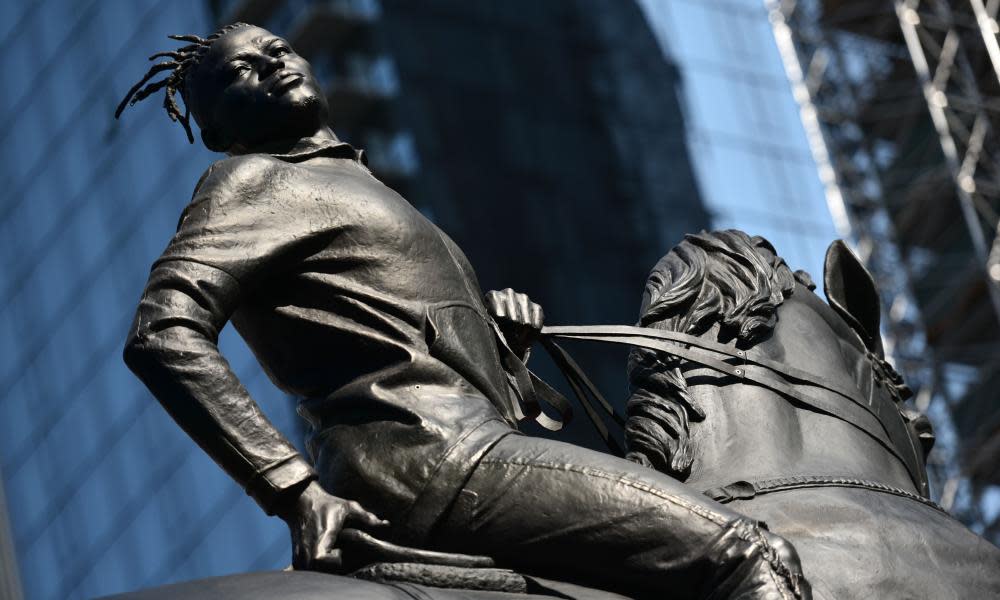Virginia museum unveils Kehinde Wiley work in response to Confederate statues

As national debate continues in the US about the fate of Confederate statues, in the Virginia capital of Richmond a monument that sends a very different message was unveiled on Tuesday.
Related: Kehinde Wiley: 'When I first started painting black women, it was a return home'
Though like many of the Confederate statues and memorials it features a martial-looking man riding a horse, Rumors of War by Kehinde Wiley is a very different piece of art.
The enormous statue outside the Virginia Museum of Fine Arts (VMFA) in Richmond is almost three storeys tall. The rider sports dreadlocks and wears a hoodie.
According to the museum, the sculpture is a direct response to the Confederate statues that line Monument Avenue just a few blocks away.
Wiley, a Los Angeles native based in New York, was inspired by a visit to Richmond in 2016, for an exhibition of his work at the VMFA. The result was a re-imagination of a statue of the Confederate general Jeb Stuart, created by Frederick Moynihan in 1907.
“In these toxic times, art can help us transform and give us a sense of purpose,” the 42-year-old artist said in a statement before the unveiling. “This story begins with my seeing the Confederate monuments. What does it feel like if you are black and walking beneath this? We come from a beautiful, fractured situation. Let’s take these fractured pieces and put them back together.”
Najee Wilson, Wiley’s model, spoke to students at Binford Middle School in Richmond on Tuesday about how the two men met.
“My message was simply, ‘Hi Kehinde, my name is Najee Wilson and I’m a fine arts muse with much experience. I’d love to work with you someday,’” Wilson said. “And he said, ‘Yes, what’s your email?’
“Being a black man from South Carolina – being the figure that’s on the horse – it’s deeply moving, and it’s deeply profound.”
Rumors of War was shown in Times Square, New York, before moving south. It now stands just a mile from Moynihan’s original on Monument Avenue, which is adjacent to the most significant piece in Richmond, the Robert E Lee Monument created by the French sculptor Antonin Mercié.
Since 2015, the Southern Poverty Law Center estimates that at least 114 Confederate symbols have been removed from their plinths and resting places across the US.
The first was taken down in New Orleans as a response to a shooting at the Emanuel African Methodist Episcopal church in Charleston, South Carolina, in June 2015. Nine black congregants were killed by Dylann Roof, a white supremacist who was pictured posing with a Confederate flag. He was sentenced to death in 2017.
In June this year, the New York Times reported that some Confederate statues have been auctioned. A Robert E Lee statue removed in Dallas, Texas, sold for $1.4m. Other figures cannot be sold as they are too damaged. Last week a Confederate monument in Nashville was vandalized, the words “They were racists” spray-painted across it.
Wiley’s statue now lives in the shadow of the United Daughters of the Confederacy’s Memorial Building, with its grand bronze doors and double cannon.
According to Newsweek, the UDC was responsible for commissioning and funding most of the Confederate statues in the south over the past century – as well as many recent attempts to obtain custody of unwanted statues such as “Silent Sam”, which was also removed in 2018 from the University of North Carolina at Chapel Hill.
In a settlement last month, the North Carolina Division of the Sons of Confederate Veterans obtained the rights to the Silent Sam statue along with $2.5m from the university to ensure its preservation.
Related: North Carolina: protesters pull down Confederate statue at university
At the VMFA ticket counter on Monday, an employee said the public response to Rumors of War had been positive. “Ninety percent good,” the young black man said. The other 10%, he addedm consisted of negative emails and phone calls.
The next day, on a rainy afternoon, hundreds turned out to witness the formal unveiling. Marching bands, dance troops and dozens of schools attended the event, which was also live-streamed.
Wearing an African print suit, Wiley said he felt overwhelmed. The statue, he said, was “not just for Richmond but everyone in the United States of America.” Recalling his visit in 2016, he said that when he saw the figures on Monument Avenue, he thought: “We can do better.”
In conclusion, he said: “This is every artist’s dream.”
The title of his statue alludes to Jesus’s speech from Matthew 24:6. “You will hear of wars and rumors of wars, but see to it that you are not alarmed. Such things must happen, but the end is still to come.”

